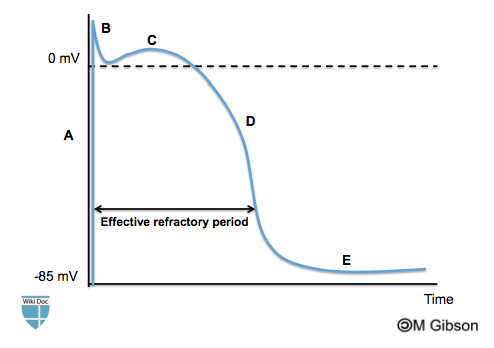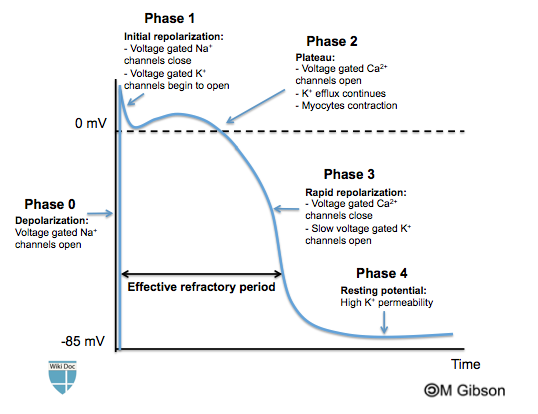WBR1015
| Author | [[PageAuthor::Rim Halaby, M.D. [1]]] |
|---|---|
| Exam Type | ExamType::USMLE Step 1 |
| Main Category | MainCategory::Physiology |
| Sub Category | SubCategory::Cardiology |
| Prompt | [[Prompt::Shown below is an image depicting the ventricular action potential. Which of the following phases of the action potential, labelled from A to E, correspond to...? |
| Answer A | AnswerA::A |
| Answer A Explanation | [[AnswerAExp::A corresponds to phase 0 of the ventricular action potential. Phase 0 is characterized by a depolarization caused by the abrupt opening of the voltage gated sodium channel.]] |
| Answer B | AnswerB::B |
| Answer B Explanation | [[AnswerBExp::B corresponds to phase 1 of the ventricular action potential. Phase 1 is characterized by an early repolarization caused by the closure of the sodium channels and the opening of voltage gated potassium channels.]] |
| Answer C | AnswerC::C |
| Answer C Explanation | [[AnswerCExp::C corresponds to phase 2 of the ventricular action potential. Phase 2 is characterized by a plateau. The plateau results from the opening of the voltage gated calcium channels leading to an influx of calcium that balances the potassium efflux.]] |
| Answer D | AnswerD::D |
| Answer D Explanation | [[AnswerDExp::D corresponds to phase 3 of the ventricular action potential. Phase 3 is characterized by a rapid repolarization caused by the closure of the calcium channels and opening of the slow voltage gated potassium channel.]] |
| Answer E | AnswerE::E |
| Answer E Explanation | [[AnswerEExp::E corresponds to phase 4 of the ventricular action potential. Phase 4 is characterized by a resting potential which is caused by the high potassium permeability through the potassium channels.]] |
| Right Answer | RightAnswer:: |
| Explanation | [[Explanation::The ventricular action potential is composed of four phases: - Phase 0 (depolarization): abrupt opening of the voltage gated sodium channel Education objective:
|
| Approved | Approved::No |
| Keyword | WBRKeyword::Action potential |
| Linked Question | Linked:: |
| Order in Linked Questions | LinkedOrder:: |

